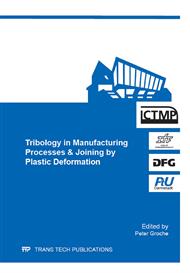[1]
Yoshikawa,H., 1969, Brittle-Ductile Behavior of Crystal Surface in Finishing, Journal of Japan Society of Mechanical Engineers, Vol. 35-10, pp.662-667.
Google Scholar
[2]
Puttick K.E., Rudman M.R., Smith K.J., Franks,A., Lindsey,K., 1989, Single-point diamond machining of glasses, Proceedings of the Royal Society of London. Ser. A, Vol. 426, pp.19-30.
Google Scholar
[3]
Shimada,S., Inamura,T., Takezawa,N., Ohmori,H., Sata,T., 1995, Brittle-Ductile Transition Phenomena in Microindentation and Micromachining, Annals of the ClRP Vol. 44, No. 1, pp.523-526.
DOI: 10.1016/s0007-8506(07)62377-4
Google Scholar
[4]
Inamura,T., Shimada,S., Takezawa,N., Nakahara,N., 1997, Brittle-Ductile Transition Phenomena Observed in Computer Simulations of Machining Defect-Free Monocrystalline Silicon, Annals of the ClRP Manufacturing Technology, Vol. 46, No. 1, pp.31-34.
DOI: 10.1016/s0007-8506(07)60769-0
Google Scholar
[5]
Nakatsuji,T., Kodera,S., Hara,S., Matsunaga,H., Ikawa,N., Shimada,S., 1990, Diamond Turning of Brittle Materials for Optical Components, Annals of the CIRP, Vol. 39-1, pp.89-92.
DOI: 10.1016/s0007-8506(07)61009-9
Google Scholar
[6]
Blake P.N., Scattergood R.O., 1990, Ductile-Regime Machining of Germanium and Silicon, Journal of the American Ceramic Society, Vol. 73-4, pp.949-957.
DOI: 10.1111/j.1151-2916.1990.tb05142.x
Google Scholar
[7]
Ichida,Y., Kishi,K., Hasuta,Y., Akbari,J., 1991, Study on Mirror Finish Grinding of Fine Ceramics (1st report), Journal of the Japan Society for Precision Engineering, Vol. 57-8, pp.1406-1412.
DOI: 10.2493/jjspe.57.1406
Google Scholar
[8]
Bifano T.G., Dow T.A., Scattergood R.O., 1991, Ductile-Regime Grinding: A New Technology for Machining Brittle Materials, Transactions of the ASME. Ser. B, Journal of Engineering for Industry, Vol. 113, pp.184-189.
DOI: 10.1115/1.2899676
Google Scholar
[9]
Wu,T., Morita,N., Yoshida,K., 1993, Study on the Diamond Cutting of Silicon Single Crystal (1st report), Journal of Japan Society of Mechanical Engineering, Vol. C59-577, pp.283-288.
Google Scholar
[10]
Yoshino,M., Shirakashi,T., 1993, Ductile Mode Cutting of Glass, Proceedings of ICMT'93, pp.1-6.
Google Scholar
[11]
Shibata,T., Ono,A., Kurihara,K., Makino,E., Ikeda,M., 1994, Cross-section Transmission Electron Microscope Observations of Diamond-turned Single Crystal Si Surfaces, Applied Physics Letters, Vol. 65-20, pp.2553-2555.
DOI: 10.1063/1.112633
Google Scholar
[12]
Kitagawa,T., Maekawa,K., 1990, Plasma Hot Machining for New Engineering Materials, Wear, Vol. 139, pp.251-267.
DOI: 10.1016/0043-1648(90)90049-g
Google Scholar
[13]
Moriwaki,T., Shamoto,E., Inoue,K., 1992, Ultra precision Ductile Cutting of Glass by Applying Ultrasonic Vibration, Annals of the CIRP, Vol. 41-1, pp.141-144.
DOI: 10.1016/s0007-8506(07)61171-8
Google Scholar
[14]
Yan,J., Asami,T., Harada, H, Kuriyagawa,T., 2012, Crystallographic effect on subsurface damage formation in silicon microcutting, CIRP Annals - Manufacturing Technology 61, p.131–134.
DOI: 10.1016/j.cirp.2012.03.070
Google Scholar
[15]
Yan,J., Asami,T., Kariyazawa,T., 2008, Nondestructive measurement of machining- induced amorphous layers in single-crystal silicon by laser micro-Raman spectroscopy, Precision Engineering Vol. 32, No. 3, pp.186-195.
DOI: 10.1016/j.precisioneng.2007.08.006
Google Scholar
[16]
Yan,J., Asami,T., Harada,H., Kariyazawa,T., 2009, Fundamental investigation of subsurface damage in single crystalline silicon, Journal of the Precision Engineering Vol. 33, No. 4, pp.378-386.
DOI: 10.1016/j.precisioneng.2008.10.008
Google Scholar
[17]
Tanaka,H., Shimada,S., Anthony,L., 2007, Requirements for Ductile-mode Machining Based on Deformation Analysis of Mono-crystalline Silicon by Molecular Dynamics Simulation, Annals of the ClRP Manufacturing Technology, Vol. 46, No. 1, pp.53-56.
DOI: 10.1016/j.cirp.2007.05.015
Google Scholar
[18]
Yoshino,M., Aoki,T., Shirakashi,T., Komanduri,R., 2001, Some Experiments on the Scratching of Silicon in-situ scratching inside an SEM and scratching under high external hydrostatic pressures", J. Mechanical Science, 43, pp.335-347.
DOI: 10.1016/s0020-7403(00)00019-9
Google Scholar
[19]
Yoshino,M., Ogawa,Y. Aravindan,S., 2005, Machining of Hard-Brittle Materials by a single point tool under High Hydrostatic Pressure, Trans. ASME, J. Manufacturing Science and Engineering, Vol. 127, pp.837-845.
DOI: 10.1115/1.2035695
Google Scholar
[20]
Yoshino,M., Aoki,T., Shirakashi,T., 2001, Scratching Test of Hard-brittle Materials under High Hydrostatic Pressure, Trans. ASME, J. Manufacturing Science and Engineering, May, vol. 123, pp.231-239.
DOI: 10.1115/1.1347035
Google Scholar


